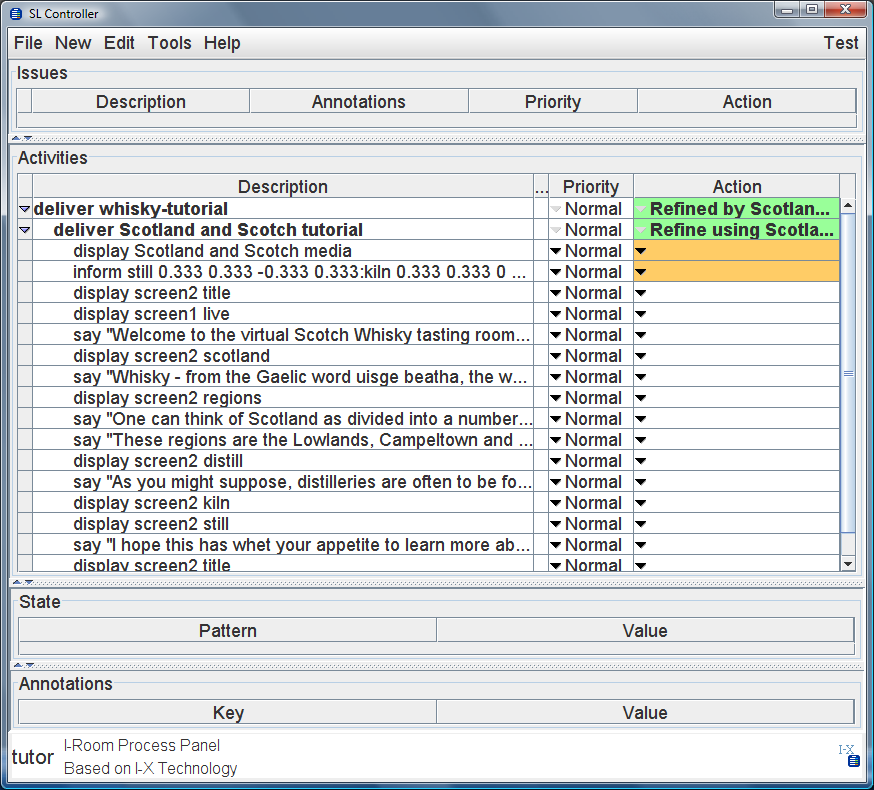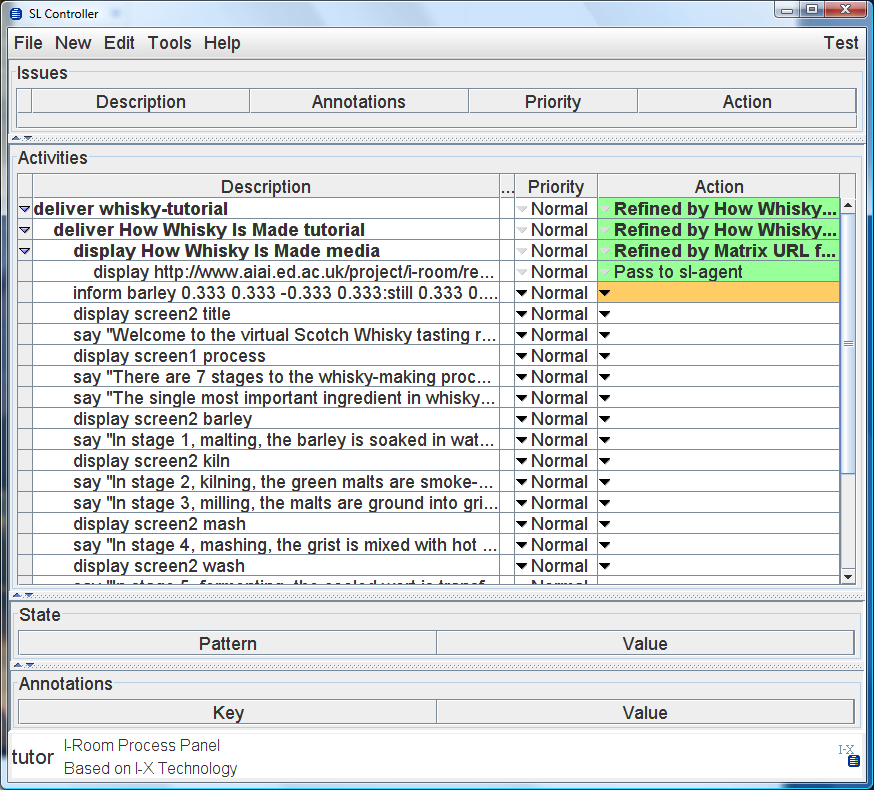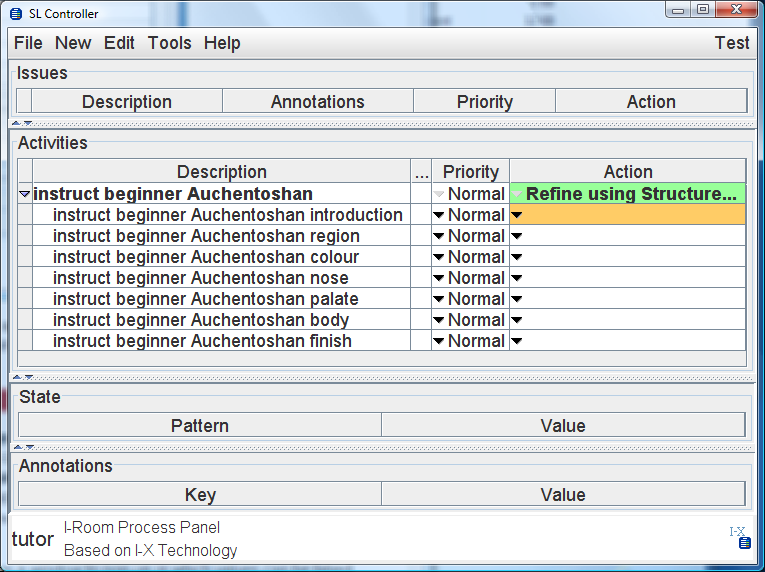 I-X for the I-Room |
We begin with a number of assumptions about the sort of tutorial that we are to support:
It is also assumed that the Tutor is running an I-X Process Panel, which provides support for delivering the tutorial, moreover, that the I-X system has been configured and is running as recommended, as have the contents of the I-Room.
Below we discuss:
With the I-X components running, and the I-Room Helper Robot activated, and the pupils' avatars in the I-Room in Second Life (and all streaming media, if the tutorial is to use video or images), the tutorial can begin. As well as using the functionality offered within Second Life by the Helper Robot, the tutor will control the tutorial using the functionality offered by the I-X Tutor Process Panel and its underlying domain model, and the additional I-X tools (accessed through the Tools menu of the panel). In particular, the I-Room Tool will be used to interact with the I-X Helper Robot in the I-Room.
There are examples of several different types of tutorial represented in the example domain included in this distribution:
To start a new tutorial the tutor should add a new activity deliver whisky-tutorial to his/her panel, either by using the New > New Activity menu option and typing the text of this activity or, more simply, by selecting the Test > Deliver whisky tutorial option.
Once activity has been added to the panel, its Action menu should include options corresponding to the three types of tutorial. Selecting one of these causes the corresponding tutorial process to be loaded onto the panel. We will now discuss each of the tutorial types in turn.
Selecting the action Refine using Scotland and Scotch tutorial adds a further activity to the tutor panel, deliver Scotland and Scotch tutorial. The Action menu for this item includes two additional refinements, corresponding to two different ways of delivering the tutorial:
Whether using the matrix or the URL approach, the "Scotland and Scotch" process that appears on the tutor's panel consists of a set of activities. In order to deliver the tutorial, the tutor should work through these activities in turn (an orange Action menu indicates which activities can be performed next). The process for the matrix version of the "Scotland and Scotch" tutorial is show below.

Depending on the activity in question, the Action menu may suggest means of performing that activity. For the initial task, display Scotland and Scotch media, for example, the Action menu offers two refinements: Refine using Live feed for Scotland and Scotch matrix and Refine using Matrix URL for Scotland and Scotch matrix. Selecting the former inserts an activity display rtsp://media.aiai.ed.ac.uk:554/vue.sdp; this is a URL for a media stream encoded in the real time streaming protocol, which, in this case is a sample video stream - in a real application, this might be replaced with a link to a 'live' video stream source. Since the use of a live video stream is dependent on the availability of additional hardware and software resources, the choice of the latter refinement is recommended for most users. Selecting this inserts instead the activity display http://www.aiai.ed.ac.uk/project/i-room/resources/vwow/tutorial/img/Scotland-and-Scotch-matrix.jpg. This is a URL of a matrix containing different visual elements complementing the content of the tutorial.
As for other display activities for which no specific refinement is suggested by the Action menu, selecting the action Pass to sl-agent will cause the activity to be delegated (via the I-X Second Life agent) to the Helper Robot in the I-Room. The Robot will then cause the video stream to be displayed on the screens in the I-Room.
The subsequent inform activity should also be sent to the Helper Robot - this provides the robot with information about the content of each of the cells of the matrix. Hence, when the Robot receives the subsequent display screen2 title, this it understands to be an instruction, for the screen called "screen2" to display the element of the matrix called "title".
The other activities in this process are say activities. For these, the tutor, assuming s/he has a microphone, may choose to simply say the string to the participants. Alternatively, the Helper Robot can be invoked to 'say' (that is, chat) the words to the participants in the I-Room by using the Action menu to pass these activities to the sl-agent.
The tutorial is considered to have finished when all the activities on the panel have been performed.
As with the "Scotland and Scotch" tutorial, and for the same reasons, there are two possible refinements suggested in the Action menu for delivering this tutorial:
Similarly, if we choose the first of these options, we are presented with further options to deliver the tutorial using a live video feed or using a pre-defined matrix for the images to be displayed.

This tutorial effectively provides a walk-through of the whisky-making process for the participants. As with the Scotland and Scotch tutorial, the tutorial is delivered by delegating display and say activities to the Helper Robot, which, in this case, provide an illustrated description of each step in the process in turn.
Selecting the action Refine using Give tasting tutorial adds a sub-activity to the panel: instruct ?avatar-type ?whisky-name.
In this activity, Mnobr>?avatar-type is a variable indicating the type of participant to whom the tutorial is to be given: this can be either beginner or expert, corresponding to the level of knowledge about whiskies that the participants already possess.
To supply values for these variables, right-click on the activity, and select Bind Variables. This causes a window to pop-up in which values can be typed. Alternatively, for convenience the Test menu provides some sample instruct activities with values already supplied.
Once one of these has been selected, or some other values have been supplied for the variables, the Action menu now provides two specific options that assist the tutor by generating text for the tasting:
Below can be seen the state of the panel after selecting to give a structured tasting of Auchentoshan whisky for beginners (one of the test menu examples).

While a confident tutor could use this sequence of activities to structure the tasting tutorial that s/he delivers 'manually' to the participants by addressing each of these aspects of the whisky in turn, the application includes knowledge-based support for automatically supplying appropriate information. Selecting the action option Refine using auto-generate text for each of these activities causes two further sub-activities to be added, a generate-text activity and a say activity. For the first of these, the Action menu provides the option to Auto-generate dialogue. This invokes an I-X 'handler', which, in this case, looks up the description of the whisky in the knowledge base and extracts the relevant information and composes it into a simple sentence. This text is now included in the subsequent say activity, and can then be relayed to the I-Room, either by the tutor speaking directly into his/her microphone (and manually 'ticking off' the task as Done) or by passing the say activity to the sl-agent, which in turn relays it to the Helper Robot which 'chats' it to the tasting participants. The appearance of a panel part way through a tutorial can be seen below; note the auto-generated text.

Selecting the option to Refine using Generate tasting notes provides a simpler decomposition into sub-activity: since this option generates a single block of flowing text describing the whisky's taste, the first sub-activity is to generate this text and the second is to say it, either directly or through the I-Room Helper Robot (via the sl-agent).